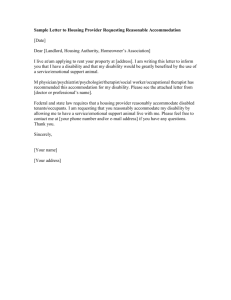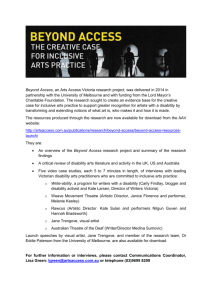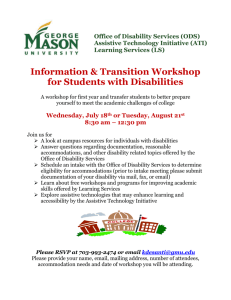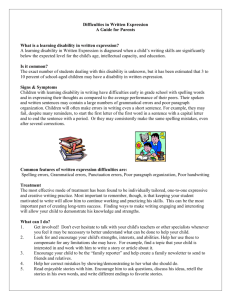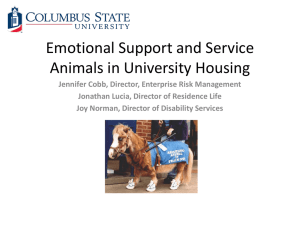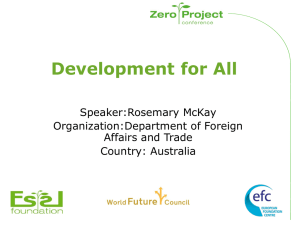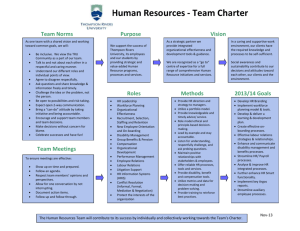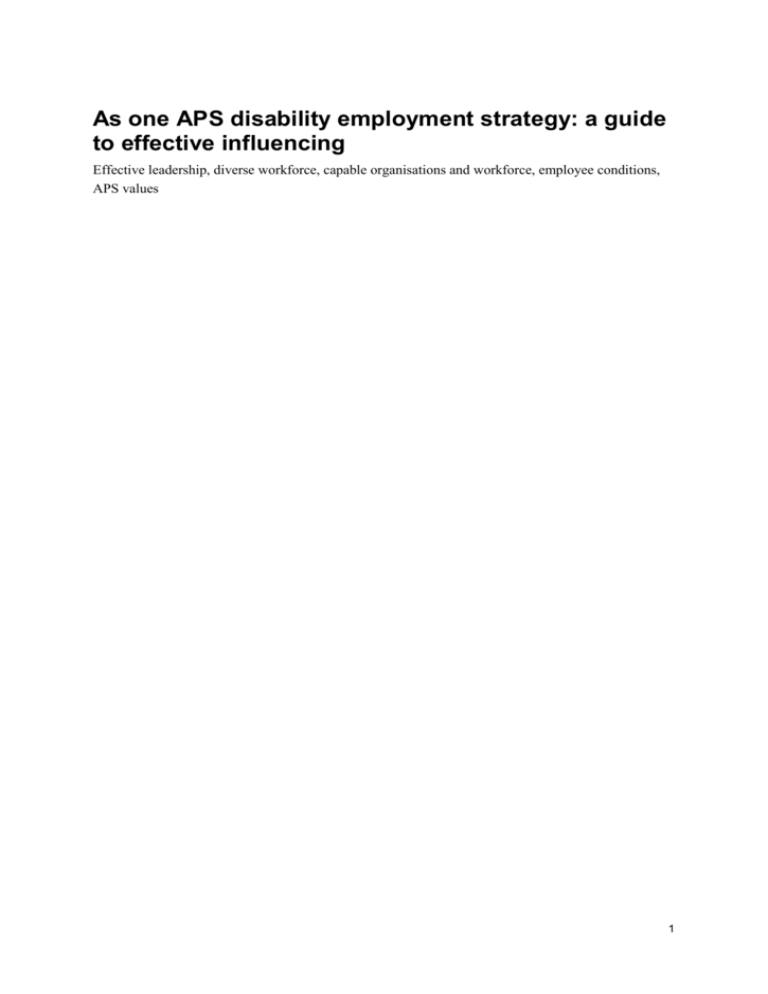
As one APS disability employment strategy: a guide
to effective influencing
Effective leadership, diverse workforce, capable organisations and workforce, employee conditions,
APS values
1
© Commonwealth of Australia 2012
All material produced by the Australian Public Service Commission (the Commission) constitutes
Commonwealth copyright administered by the Commission. The Commission reserves the right to set out the
terms and conditions for the use of such material.
Apart from any use as permitted under the Copyright Act 1968 and those explicitly granted below, all other
rights are reserved.
Unless otherwise noted, all material in this publication, except the Commission logo or badge, the
Commonwealth Coat of Arms, and any material protected by a trade mark, is licensed under a Creative Commons
BY Attribution 3.0 Australia licence.
or
Details of the licence are available at <http://creativecommons.org/licenses/by/3.0/au/>.
Attributing Commission works
Use of Commission material licensed under a Creative Commons BY Attribution 3.0 Australia licence requires
you to attribute the work in the manner specified by the Commission (but not in any way that suggests that the
Commission endorses you or your use of the work). Almost any form of words is fine provided that you:
provide a reference to the publication and, where practical, the relevant pages
make clear whether or not you have changed Commission content
make clear what permission you are relying on, by including a reference to this page or to a humanreadable summary of the Creative Commons BY Attribution 3.0 Australia licence
do not suggest that the Commission endorses you or your use of our content.
For example, if you have not changed Commission content in any way, you might state: ‘Sourced from the
Australian Public Service Commission publication [name of publication]. This material is licensed for reuse
under a Creative Commons BY Attribution 3.0 Australia licence.’
If you have made changes to Commission content, it would be more accurate to describe it as ‘based on
Australian Public Service Commission content’ instead of ‘sourced from the Australian Public Service
Commission’.
Enquiries
For enquiries concerning reproduction and rights in Commission products and services, please contact
communicationsunit@apsc.gov.au.
Acknowledgements
The Australian Public Service Commission wishes to thank everyone who took the time to contribute their
thoughts, ideas and feedback to the development of this strategy.
ISBN: 978-0-9871594-4-1
2
Contents
Introduction ............................................................................................................................................. 4
Using this guide .................................................................................................................................. 5
Section 1: understanding influence and putting it into practice .............................................................. 7
What is influence?............................................................................................................................... 7
Principles of persuasion ...................................................................................................................... 9
Targeted communication .................................................................................................................. 11
Strategy ............................................................................................................................................. 15
Section 2: reflection to achieve better influencing outcomes ............................................................... 18
Being authentic ................................................................................................................................. 18
Case study – Department of Human Services ................................................................................... 19
Dealing with resistance ..................................................................................................................... 21
Conclusion ........................................................................................................................................ 22
Appendix ............................................................................................................................................... 24
Influencing preparation template ...................................................................................................... 24
References ............................................................................................................................................. 26
Books ................................................................................................................................................ 26
Articles .............................................................................................................................................. 26
Websites ............................................................................................................................................ 26
3
Introduction
What if we needed to provide support for a person with a disability but we just didn’t know what to
do? We would feel awful....
Oh I wish we could hire more people with a disability but really it wouldn’t be fair to them as we just
couldn’t support them here given the work we do
Our budget is already under so much pressure, we simply couldn’t afford to make any workplace
adjustments for someone to work here
Heard it all before? Despite good intentions and a succession of initiatives over several years, people
with disability remain significantly under-represented in the Australian Public Service (APS)
workforce. It is difficult at times to understand why this continues to be the case. Research recognises
the need for and contribution made by those with disability in the APS. We know the benefits of
having a workforce that reflects the community we serve. Agencies post detailed disability action
plans on websites and, in many instances, include disability employment in strategic and business
plans. And yet the number of individuals with disability in the APS is not what it should be. As stated
recently by an APS officer with disability employment responsibilities: “The rhetoric is there but the
reality is different.”
Why is this so? What stops us from building more diverse workplaces? In most instances, this
rhetoric-reality gap can be distilled to one key factor. Disability employment is still considered a ‘nice
to have’, not a ‘must have’ to achieve business outcomes. This is a result of a lack of understanding,
incorrect assumptions and in some cases ignorance – all of which creates a deep sense of reluctance to
explore hiring more people with a disability. It even creates fear. And where this reluctance and
resistance exist, change will be slow at best.
Motivation for change is critical. As human beings, we are not always rational in our behaviour or in
our choices1. For example, we all know that we can be fit and healthy as long as we exercise
regularly, eat healthy food, drink alcohol in moderation and don’t smoke. However, the reality is that
a proportion of the population continue to ignore the science and the facts concerning the impact of
unhealthy behaviour and do the opposite of what is recommended. This illustrates that while we can
read facts about an issue, often it is our own individual preferences and motivators which will dictate
how we behave - even when this is not necessarily rational.
Similarly, in encouraging greater support for workers with disability most people will agree that this
is a ‘good thing to do’. However, often this is not linked to practical actions that will achieve a
positive outcome. In some instances, this is because the individual does not perceive that the issue is
relevant or important to the organisation. Trying to change behaviour at the individual and the
organisational level then becomes one of understanding preferences and motivators of those in the
organisation and targeting communication and actions based on this understanding.
For a good discussion of the social marketing approach to changing behaviour at the individual level, see “Changing
Behaviour – A Public Policy Perspective”, Australian Public Service Commission, 2007.
1
4
The As One – APS Disability Employment Strategy aims to strengthen the APS to be a more
progressive and sustainable employer of people with disability, and improve the work experience of
people with disability. This guide provides a comprehensive approach to influencing key decisionmakers in your organisation to achieve the initiatives in the As One strategy. It will help human
resource practitioners overcome resistance through the use of influence and offer them alternative
ways of promoting disability employment as an integrated component of workforce and business
planning. It explores the way in which we frame the issue of disability employment; shifting it from
simply a moral argument (‘it’s the right thing to do’) to one which is a key strategy in achieving
business outcomes.
Using this guide
This guide is organised into two sections. Firstly it outlines key concepts related to influence and
persuasion and secondly it identifies some key personal characteristics relating to effective
influencing. In many ways it’s a collection of ideas that will resonate differently for different readers.
Some may wish to go into the fine detail of all of the approaches provided while others may wish to
work with one for two. The aim is to equip you with a range of tools and approaches you can use in a
variety of settings.
“Few are open to conviction, but the majority of people are open to persuasion.”
Johann Wolfgang von Goethe
It is also useful to consider the framework developed by the Australian Public Service Commission in
relation to leadership development (Figure 1). For Human Resources practitioners as you lead change
in disability employment in the APS, understanding your own development needs can be enhanced by
considering the different lenses on development highlighted by the Knowing | Doing | Being
framework:
Understand the key concepts and theory about leading and influencing this kind of change
(knowing).
Developing the skills and behaviours to lead and influence change (doing).
Developing your understanding of your own values, self awareness, social skills and awareness of
how your actions and intent impact on those around you (being).
5
Figure 1: Knowing | Doing | Being framework
Knowing
People: people management; change management; stakeholder management
System: strategic management; analytical skills; public service ‘craft’; government savvy
Business: financial/value management; program management; risk management; technology skills;
business case
Professional: Public policy; delivery; regulatory; professional/specialist
Doing
Shapes strategic thinking
Communicate with influence
Exemplifies personal drive and integrity
Cultivates productive working relationships
Achieves results
Being
Self: authenticity; self awareness; self motivation;
will/passion/conviction/courage/agility/adaptability; empathy; resilience
Others: self regulation; social awareness; social skills
Situation: situational awareness; stewardship; collegiality; public service ethics and integrity
6
Section 1: understanding influence and putting it into practice
This section will examine some of the theories behind what tends to persuade us at a general level and
consider the approaches which have been demonstrated to influence or change our views. We will
then explore a model which describes our basic thinking preferences as well as how we like to be
communicated with.
What is influence?
Influence
–
a
definition:
Oxford
Dictionary:
“[mass noun] the capacity to have an effect on the character, development, or behaviour of someone
or something, or the effect itself.”
Effective disability employment strategies in organisations and the APS more broadly have a
significant role to play in supporting an effective and productive public sector. When successful, these
strategies make organisations more effective, more in tune with the needs and concerns of the citizens
it serves and arguably more efficient, innovative and flexible.
However, it is often seen as the role of human resource practitioners to solve the problem of disability
employment and retention. Yet in many cases, these individuals do not hold senior decision-making
roles. Human resource practitioners who successfully promote disability employment in their
organisations generally do so through the strategic use of a variety of influencing skills and
approaches, working in partnership with business areas and building support across the organisation,
see Figure 2.
Influence often involves negotiation. To influence, we need to be able to offer value in terms of what
that person is committed to, as well as ask for opportunities to demonstrate that value.
Influence is often about problem solving, working through perceived barriers to an effective and
sustainable outcome.
Influencing in an APS environment generally involves influencing groups of people and teams.
This is particularly the case for teams that may employ people with a disability. The more that
people embrace the value of employing people with disability in their teams, the more the issue
becomes one of mainstream management, rather than an add-on activity.
Influence in disability employment invariably involves us in managing change – changing
perceptions, attitudes and in some cases work environments.
Finally, influencing to achieve better employment outcomes for people with disability is about
leadership and role modelling – demonstrating how to support people with disability in the
workplace to create a productive team, leading yourself, your own organisation and ultimately
leading across the APS.
7
Figure 2: Influencing skills.
Influencing is a skill that we all have and like any skill it can be developed. Effective development
occurs through understanding and appreciating:
The components of effective influence.
The context in which you influence.
The need for you to apply and practice your skill for it to further develop.
In the APS context, effective influencing is supported by three capabilities:
An ability to respond to and target particular forms of communication.
An understanding of the psychology of persuasion that sits behind our willingness to be
influenced.
An ability to develop simple influencing strategies and carry them out.
These are shown in Figure 3.
8
Figure 3: Framework for influence (source: John Robinson Consulting Services 2012).
We will now explore each one of these three elements and how they apply to disability employment in
the APS.
Principles of persuasion
There appear to be three crucial elements to effective influencing within an APS environment. The
first of these is an understanding of and an ability to apply Principles of Persuasion.
Effective and sustained influence is difficult without an understanding of what works to persuade,
motivate and influence human beings to do things. Fortunately we have over five decades of
significant research to call on to assist us in this understanding.
Robert B. Cialdini is recognised as one of the most informed writers on influence. His book Influence,
The Psychology of Persuasion was first published in 1984 and has continued to be updated since.
Cialdini scoured research literature on persuasion and influence to identify six fundamental principles
of influence that can be applied in the workplace:
The Principle of Liking – people like those who like them.
The Principle of Reciprocity – people repay in kind.
The Principle of Social Proof – people follow the lead of similar others.
The Principle of Consistency – people align with their clear commitments.
The Principle of Authority – people defer to experts.
The Principle of Scarcity – people want more of what they can have less of.
9
Principle 1: The principle of liking
The first principle confirms the need for those involved in facilitating disability employment to
cultivate a network of individuals who respect and support them in their work.
The application: Uncover real similarities and offer genuine praise.
Research indicates that people are more influenced by those who they believe are similar to them and
those that provide them with praise. In developing a network to support your work, spend some time
getting to know your colleagues and identifying and surfacing the similarities you may have. It is
likely that you and those you work with will have some experiences in common.
Praise is also an important factor in influence. The application in our context can be as simple as
recognising a positive comment in relation to disability employment that may occur during a
conversation or perhaps more formally recognising inroads made in employing a person with
disability. Whatever the application, it is important that it be genuine.
Principle 2: The principle of reciprocity
The second principle confirms that individuals tend to provide support to those that they have
received support from.
The application: Give what you want to receive.
So what do you have to give? What you primarily have is very valuable – information on disability
employment, such as how it may best be achieved, and an understanding of the benefits that can be
gained from the employment of people with disability. It is also likely that you are the custodian of
the ‘rules and regulations’ that govern disability employment in your organisation. By providing
something valuable (timely, clear and accurate information) to decision-makers in your organisation,
you are setting up an opportunity for them to reciprocate your positive and helpful behaviour.
Principle 3: The Principle of social proof
The application: Use peer power whenever it’s available.
People tend to follow the lead of others whom they respect. This is why it is so important in disability
employment to have visible senior management commitment to employment initiatives. It is also why
it is necessary to effectively market every disability employment success, naming the managers and
decision-makers involved (where appropriate).
Principle 4: The principle of consistency
The Application: Make commitments active, public and voluntary.
Research shows that a choice made actively, i.e. one that’s spoken out loud or written down or
otherwise made explicit, is considerably more likely to direct someone’s future conduct than the same
choice left unspoken. This is why formal commitments to employing people with disability are so
important.
10
Principle 5: The principle of authority
The application: Expose your expertise. Don’t assume it is self-evident.
The use of an individual wearing white coats and carrying clipboards to signal ‘expert’ status is
synonymous with popular advertising. This is because evidence tells us that a significant proportion of
the population will respond positively to such ‘expert’ images. This is not to suggest that you rush out
and buy a lab coat and clipboard. Your expertise is real and genuine. In your role, as indicated earlier,
you are the custodian of valuable organisational information on disability employment – you are the
expert in this area.
Principle 6: The principle of scarcity
The application: Highlight unique benefits and exclusive information.
Research shows that items and opportunities are seen to be more valuable as they become less
available. Promote workplace awards for those teams which support people with disabilities and
engender some cross-organisation competition for these awards. Ensure that prizes are highly valued
and directly linked to the team effort which earned the award, such as additional resources, training or
conference attendance, etc.
The application of the Principles
The Principles of Persuasion are most effective when used in combination; not necessarily all at once,
but in a discrete combination, tailored to the context of the circumstances. Also, using one or two
principles constantly is generally ineffective.
“People will do almost anything if you give them a good why.”
Nietzsche
Targeted communication
“Effective influencers are multi-lingual: They use the language of objects and a variety of other
languages to lead others to think or act in a certain way. As long as the purpose behind their use of
those languages is an ethical purpose, designed to benefit someone or something beyond the
influencer, then the influencers are acting with integrity. To effectively employ body language and
paralanguage and silence and neurolinguistics and proxemics (the use of space) is to understand that
different folks need different strokes. Your ability to use a wide range of tools is a tribute to your
understanding of human dynamics.”
Marlene Caroselli, Influence: Key to the Door of Leadership
Ideally an APS workplace will reflect the broader world in its diversity and richness. This diversity
however provides both a challenge to and an opportunity for influence.
Research on the brain has led to an understanding that each of us has a preferred way and mode of
thinking that affects the way we take in and process information. The awareness of one’s own
thinking style and the thinking styles of others, combined with the ability to act outside of one’s
preferred thinking style, is known as Whole Brain Thinking.
11
Whole Brain Thinking uses colour as a metaphor for describing thinking preferences. In Figure 4, the
brain is shown as a circle. The four quadrants represent areas in the brain, with the blue (A) and
yellow (D) quadrants representing the left and right sides of the cerebral cortex respectively, and the
green (B) and red (C) quadrants representing the left and right sides of the limbic brain. The theory
behind the model developed by Ned Herrmann suggests that we each have preferences about which
parts of the brain we use and this affects the way we like to receive information.
Using Whole Brain Thinking is about using the thinking preferences in each of the four quadrants. It
enables you to take a comprehensive view of any situation and look at it from a variety of
perspectives. The result—you have literally thought of everything. Figure 5 describes aspects of each
thinking preference.
Figure 4: Whole Brain Thinking2
Figure 5: Differences in processing modes.3
A – upper left
B – lower left
C – lower right
D – upper right
2
The Whole Brain® Model is a trademark of Herrmann International, Inc. and is reproduced with written permission for
display in this text. ©Copyright 2010 Herrmann International, Inc. All Rights Reserved.
3
©Copyright 2010 Herrmann International, Inc. All Rights Reserved.
12
Descriptors
Logical; factual;
rational;
critical;
analytical;
quantitative;
authoritarian;
mathematical
Technical reader;
data collector;
conservative;
controlled;
sequential;
articulate;
dominant;
detailed
Musical; spiritual;
symbolic;
talkative;
emotional;
intuitive
(regarding
people); reader
(personal)
Intuitive
(regarding
solutions);
simultaneous;
imaginative;
synthesiser;
holistic; artistic;
spatial
Skills
Problem
solving;
analytical;
statistical;
technical;
scientific;
financial
Planning;
regulatory;
supervisory;
administrative;
organisational;
implementation
Expressing ideas;
interpersonal;
writing
(correspondence);
teaching; training
Integrative;
visualising;
causing change;
conceptualising;
generating ideas;
trusting intuition
Typical
phrases used
‘Tools’;
‘hardware’;
‘key point’;
‘knowing the
bottom line’;
‘take it apart’;
‘break it down’;
‘critical
analysis’
‘Establish
habits’; ‘we have
always done it
this way’; ‘law
and order’; ‘self
discipline’; ‘by
the book’; ‘play
it safe’;
‘sequence’
‘Team work’; ‘the
family’;
‘interactive’;
‘participatory’;
‘human values’;
‘personal
growth’; ‘human
resources’;
‘develop teams’
‘Play with an
idea’; ‘the big
picture’; ‘broadbased’;
‘synergistic’;
‘cutting edge’;
‘conceptual
block busting’;
‘innovative’
Typical
derogatory
phrases
(zingers) used
by others
‘Number
cruncher’;
‘power hungry’;
‘unemotional’;
‘calculating’;
‘uncaring’;
‘cold fish’;
‘nerd’
‘Picky’; ‘can’t
think for
himself’;
‘unimaginative’;
‘one-trackmind’; ‘stick-inthe-mud’; ‘grinds
out task’
‘Bleeding heart’;
‘talk, talk, talk’;
‘touchy-feely’; ‘a
push over’; ‘soft
touch’; ‘gullible’;
‘sappy’
‘Reckless’;
‘can’t focus’;
‘unrealistic’;
‘off-the-wall’;
‘dreams a lot’;
‘undisciplined’;
‘head in the
clouds’
Whole Brain Thinking exercise
The application of Whole Brain Thinking first involves you establishing your dominant thinking
preference. Be aware that we have a capacity to use all preferences, it’s just that we tend to find some
easier to use than others and as such prefer to use them.
Observe the way you work and in particular the way you prefer to communicate. Which thinking
preference does this most closely align with?
Observe the work patterns and communication preferences of someone that you seek to influence.
What thinking preference does their behaviour most closely align with?
13
If you share a thinking preference it is likely (all other things being equal) that your communication
will be effective and influential. If you do not share thinking preferences, things may be a little more
challenging.
For example, when promoting disability employment, an individual with a strong red preference is
likely to focus on:
The benefit employment provides to people with disability through their inclusion in the social
fabric of the workplace and the nation more broadly.
The rights of people with disability to actively participate in employment.
The opportunity that disability employment provides for the development and sustainability of
work teams.
While all of these points are valid they are unlikely to be persuasive to an individual with a strong
blue preference. This individual prefers to respond to information that is factual, quantitative and
rational. An influential blue argument for supporting disability employment in a workplace would
include:
A well-constructed business case outlining the scale of the skills shortage in future years, the
return on investment in terms of lower turnover and a cost benefit analysis.
Data on the cost of reasonable adjustments indicating that roughly 80% of adjustments cost less
than $500 per person.
The statistics on attendance and productivity associated with workers with disability.
The stated policy framework and history surrounding disability employment in the APS and public
sector more broadly.
Research relating to the positive impact diversity has on the performance of work areas.
Workplace examples where the employment of workers with disability has resulted in measurable
improvements in team effectiveness and productivity.
Individuals with a strong green preference are likely to respond to arguments that:
Cite the appropriate regulations and rules that are in place to support disability employment.
Provide a clear process of recruitment and retention of workers with disability.
Clearly articulate any administrative arrangements associated with employing a worker with
disability.
Detail risk and mitigation strategies associated with disability employment.
Those with a dominant yellow preference are likely to respond to propositions that:
Focus on the big picture of the employment of Australians with a disability.
Link other business initiatives in an organisation (or more broadly) to disability employment.
Include initiatives that have not been attempted before, particularly those that appear to be
innovative.
14
Involve change to the status quo.
Crafting your communication and influencing around thinking preference is likely to result in you
being more effective in mounting and supporting arguments for the implementation and ongoing
support of disability employment initiatives.
“The single biggest problem in communication is the illusion that it has taken place.”
George Bernard Shaw.
Strategy
When developing strategies to influence stakeholders, it is useful to draw on principles of social
marketing. These recognise that logic or an appeal to ‘what is right’ is often not enough to influence
behaviour. The twelve principles (or actions) of an effective social marketing approach include:
Take advantage of prior and existing successful campaigns – for example:
Draw on themes from other successful culture change efforts.
Target people most ready for action, i.e. those who are directly affected – for example:
Ask those who employ people with disabilities and those with disabled family members or
friends to become champions, both officially and non-officially in the workplace.
Promote single, doable behaviours, one at a time – for example:
All jobs advertised include disability-friendly references.
Awareness training for all staff and the identification of disability champion at a senior level in
the organisation.
Identify and remove barriers to attracting and retaining people with disabilities – for example:
Promote workplace discussion around issues of disclosure and real and perceived barriers (such
as culture and work design).
Many of the As One initiatives target improving recruitment processes to enable more
candidates with disability to enter the APS.
Bringing in a specialist consultant4 to provide human resource managers and line managers
with a free assessment of the costs involved and the subsidies available to make reasonable
adjustments.
Bring real benefits into the present – for example:
4
JobAccess is an information and advice service funded by the Australian Government. It offers help and workplace
solutions for people with disability and their employers. JobAccess is an initiative of the Australian Government to support
the employment of people with disability. It includes a comprehensive, easy to use website and a free telephone information
and advice service where you can access confidential and expert advice on the employment of people with disability.
15
Cost benefit analysis, targeting the real average cost of a workplace adjustment versus cost of
staff turnover. It is important to be able to use business language as part of the influencing
strategy, presenting a disability employment strategy as a business case which includes
measures such as return on investment and highlighting costs of turnover.
Highlight costs of competing behaviours – for example:
The cost of not doing anything.
The cost to the organisation’s reputation, particularly if the organisation provides front-line
services to the public.
Promote a tangible object or service to help target audiences perform the behaviour – for example:
Assistance from a specialist to coordinate and support the workplace through business planning
processes.
Consider setting voluntary targets for employment of people with disability.
Consider non-monetary incentives in the form of recognition and appreciation – for example:
Where appropriate, highlight good news stories that involve innovative approaches to
supporting a person’s specific needs, while achieving positive outcomes for the group or team.
Have a little fun with messages – for example:
Source a short film that uses humour to demonstrate how some people feel uncomfortable when
they interact with people with disability.
When phrases become overused or are associated with negative connotations, try some
creativity to help get the message across. Try replacing the term ‘reasonable adjustment’ with
‘we will need to make sure that there is a fair fit for the person with a disability and the
workplace’.
Use media campaigns to influence people at the point of decision making – for example:
Develop an internal marketing and awareness campaign which directly links to the
organisation’s recruitment process and is reflected in the tools to support selection processes.
Use the campaign livery in the public advertising of positions.
Get commitments and pledges – for example:
Link achievement of disability employment outcomes to the agency’s business planning and
include key performance indicators for divisional or group managers.
Use ongoing internal actions and awareness campaigns to ensure that the approach is sustained.
Many great initiatives falter after initial success as they are delivered as a once-only campaign or
set of actions. Instead, one should aim for continued engagement and take steps to keep the process
going. For example:
Keep up an ongoing stream of information.
Set up and support unofficial mentoring arrangements.
16
Encourage people to seek assistance in either supporting a person with a disability or working
with a disability.
Develop a simple resource kit.
Develop a calendar of events and actively engage champions to ensure the issue is kept frontof-mind for all staff and managers.
17
Section 2: reflection to achieve better influencing outcomes
In this section, you’ll find tools to help you prepare for an influencing exercise and a model of how
people tend to respond during change and transition. Importantly, this section also discusses how to
overcome challenging or uncomfortable resistance to change.
Learning is fundamental to developing influencing capabilities – if we can recognise areas for
improvement and address these, we will develop more flexible approaches and be able to effectively
‘think on our feet’ in different situations.
Here are some questions that human resource practitioners are encouraged to consider before, during
and after an influencing exercise:
About myself:
Am I authentic?
Am I resilient?
Can I show empathy?
Do I have the courage to see this through?
How can I best improve my capabilities?
About others:
How do others respond to me?
What social skills do others demonstrate?
About the situation:
How is the situation likely to play out?
What was the outcome?
How did I/others respond?
In this situation, how could I have performed better?
What can I do to improve for next time?
Being authentic
Centuries ago the Greek philosopher Aristotle pondered the nature of influence and concluded that to
be influential one had to focus on providing factual information. He noted, however, that fact alone is
not necessarily influential. Fact needs to be supported by building an emotional arousal in those that
you wish to influence, exciting them to your cause. Again, fact and emotion may not, in themselves,
prove to be influential. The third element of the formula is to ensure that you are credible.
This means that you need to be viewed as honest, believable and trustworthy by those you wish to
influence. Preparation is the key. A suggested approach to preparing for persuasion is described in
Figure 6. You may also like to use the planning template in the Appendix.
18
Figure 6: A process for putting influence into action.
Case study – Department of Human Services
The portfolio of Human Services has a long standing commitment to support employees with
effective workplace modifications, rehabilitation and return-to-work best practice. They are
committed to improving workforce participation for people with disability by providing an inclusive
workplace, targeted support and effective governance. The following is an account of how staff within
Centrelink, and subsequently, the Department of Human Services, used influence to overcome
resistance to the establishment of a national Accessibility Support Unit in the newly formed
department.
19
In 2011 the Department of Human Services (DHS) integrated the agencies of Centrelink, Medicare
Australia, Child Support Agency, the Family Assistance Office and CRS Australia into their portfolio.
Prior to the agency integration, Centrelink had identified that many staff with disability and injury,
and their managers, became frustrated with the disparate and ad-hoc processes associated with the
provision, allocation, training and support for accessibility-specific adjustments necessary for them to
meet job requirements.
It became apparent a new approach was required to overcome this barrier to employing people with
disability or injury. Staff working in the human resources (HR) area recognized the need for a national
coordinated approach to bring together employees with disability, HR and IT to provide a complete
end to end service for the employee and ultimately to achieve results for the agency.
Prior to the newly formed DHS, Centrelink had an Accessibility Steering Committee whose role it
was to ensure that staff with disability, particularly those reliant on speech recognition and screen
reading assistive technologies, had equal access to internal and external content and applications.
Where issues were found, they were addressed efficiently and effectively. This model had been
working well within Centrelink’s national office in Canberra.
Based on this model, a proposal was presented to the Centrelink Executive in October 2009 to
implement the Accessibility Support Unit nationally across the newly integrated agency. The proposal
called for the unit to be responsible for a coordinated approach to supporting staff with accessibility
needs. This specifically included the provision of support, training and advice to those staff currently
employing workplace assistive technology but also included supporting managers and HR teams to
ensure assistive technology was appropriately provisioned. Other functions included the development
of business strategy and policy to ensure overall equality of access and finally an evaluation role to
ensure that the Department’s applications were accessible, compatible and operable with assistive
technology for the Department’s clients.
This proposal encountered a number of major barriers and resistance from decision-makers in the
Centrelink Executive. It was perceived that this service was already in existence; that the need for a
specific unit was not seen as a priority when considered against other funding priorities; the group of
employees it would support were somewhat ‘invisible’, having no coordinated ‘voice’; and the lack of
ownership among the agency’s senior executive of the issues employees with accessibility needs were
facing. Funding approval for the Unit based on this initial proposal was not granted, therefore the
disparate and ad-hoc processes appeared set to continue within the newly formed department.
However, following the integration of the agencies to become the Department of Human Services, the
proposal was tabled again with the Executive in May 2010. On this occasion, the proposal was
accepted, with costs of establishment shared across all the DHS agencies. The Unit commenced
formal operations in August 2010. Those presenting the proposal a second time employed a series of
influencing tactics to increase support for implementation of the Unit. Highlights of this strategy
were:
Emphasising the streamlined way the Unit would be able to raise awareness of accessibility issues
within the agency, thereby increasing knowledge, addressing incorrect assumptions and making it
easier for staff and managers to engage with staff or potential staff requiring accessibility support.
20
The proposal outlined training which would be provided to employees which would enable staff
with disability and injury to perform the inherent requirements of the job more efficiently. This
essentially linked support for employees with disability with the business benefit of improved
productivity.
By focusing on the centralised management of software allocation further business benefits were
possible, by providing software within short timeframes to those who needed it, again improving
productivity.
The proposal linked the need to support departmental staff with disability and their managers with
the requirement across all Government agencies to address longer term organisational challenges,
including how to make systems more accessible. (This is a key requirement of the Web Content
Accessibility Guidelines 2.0 released by the Australian Government in 2010.)
The key breakthrough in having the proposal to establish the national Accessibility Support Unit
endorsed was in securing Senior Executive commitment. This was achieved in part by demonstrating
the practical and procedural issues faced by people using assistive technologies to members of the
Departmental Executive. HR staff engaged a number of Senior Executive disability champions,
including as part of a wider move to appoint disability champions across the APS. These champions,
who were senior role models in the Department, played a key role in advertising the benefits of an
accessible and inclusive workplace for all staff across the department rather than just limiting the
benefits to an individual with a disability or focusing only on one particular area of the workplace.
In summary, the establishment of the Unit was a key strategy which demonstrated the Department’s
commitment to the employment of people with disability, to promote the Department as a disability
friendly workplace and to attract and retain people with disability. It also allowed the Department to
demonstrate to the public that it understood the issues that many of its clients who have a disability
encounter by having a diverse workforce reflective of the community it serves.
Dealing with resistance
Perhaps the biggest challenge encountered by human resource practitioners in promoting disability
employment within the APS involves dealing with resistance from decision makers, managers, team
leaders and employees. In most cases this resistance behaviour is a direct response to a need to change
rather than a negative view on the employment of people with a disability.
Resistance to new ideas and work procedures is part of the normal process of change. When
individuals are asked to change ideas and work practices there are traditionally four stages that they
go through. The first is denial, followed by resistance, exploration and, finally, commitment.
The language people use in relation to the change is normally an indicator of the stage they are at.
Figure 7 outlines the broad stages people typically go through in dealing with change.
21
Figure 7: The stages of change
Moving individuals from resistance to exploration is normally the hardest part of the transition
process. This is best done through:
Giving good quality information on the proposed change.
Presenting information in a manner that resonates with the individual(s) involved.
Providing options as to how the change can best be achieved.
Keying into the ‘what’s in this for me?’ factor. Self-interest is a powerful motivator for most of us.
If we are to truly embrace something new we have to believe that we are receiving something
positive from the change.
Being tenacious. The stronger the resistance, the more likely that repeated provision of information
and options will be needed.
Conclusion
The As One strategy sets out a comprehensive, integrated suite of actions which is aimed at raising
awareness about employing people with disability, removing barriers to employment and increasing
workforce participation by people with disability. The approach is designed to welcome and engage
people with disability more effectively and to ensure that the workplace can be tailored and flexible to
the needs of not only those potential staff members with a disability, but also of other staff.
This guide highlights the need to look at changing culture, perspectives and behaviour as an exercise
in influence, to support the actions outlined in the As One strategy. Most people will readily accept the
logic of increasing the level of employment of people with a disability at a theoretical level. But it is
often a lack of knowledge, inaccurate assumptions and prejudices as well as a lack of understanding
that prevents action. In this guide, we have set out a series of tools and suggestions to help the human
resource practitioner to lead change and effectively influence people in order to address these
concerns. In large part it is based on the need to understand the issues and concerns of the target
audience, tailor the message accordingly, and prepare for resistance and setbacks.
22
In the APS there is heavy competition for resources and skills and staff shortages are expected to
worsen. Also, the working population is ageing and as such the push to increase employment of
people with a disability needs to become a central strategy in assisting organisations to survive and
flourish. If it is not linked to the success of the organisation it will be seen as an optional, ‘nice to
have’ strategy which no one is prepared to invest in, particularly when faced with sizeable budget
constraints. To win hearts and minds, disability employment strategies must be linked to achieving
greater organisational success in key areas such as productivity, client service, staff satisfaction and
lower turnover. It must be seen as not just human resources’ business, but important to the business of
the entire organisation and to the APS as a whole.
One final note: Culture change requires two main ingredients – time and commitment. True change
may take time and will be built on small successes as well as inevitably some setbacks. This is where
the commitment is critical, particularly from senior staff. In embarking on this strategy it is important
to frame it as a long-term commitment (rather than a short project) and integrate it into business and
workforce planning.
23
Appendix
Influencing preparation template
Stage 1. Objective: what do I want to be influential on?
Describe what you want to influence. For example, “I want to influence a particular branch head to
engage a specific individual with disability, in a specific role.”
Stage 2. Who do I need to influence?
List those who you need to influence to achieve your objective. For example, the branch head,
individuals in the workplace, the individual you are seeking to place.
Stage 3. How will I know I have been successful in my influencing?
Identify what you will see if your influence has been effective. For example, “If I am successful in
influencing the branch head, he/she will respond positively to my suggestion as to how best place the
person with a disability in the workplace.”
Stage 4. The ‘Aristotle test’ – is my influencing approach based on fact? Does it have an
appropriate level of emotion? And, is it credible?
List the elements that make it so. For example, “I have researched the work demand in the branch,
now and in the near future and there is a need for an extra resource (Fact). The person I am seeking to
place has relevant skills and experience (Fact). The branch head is a high achiever and my proposal
offers him/her an opportunity for the branch to perform at a higher level (Emotion). I have developed
my influencing arguments in a way that recognises the needs of the branch and provides a business
solution to a resource demand (Credibility).
Stage 5. What are the probable thinking styles of those I need to influence?
Return to step 2 and consider who it is that you need to influence. What is their probable dominant
thinking style(s)? Have you crafted your influencing arguments to suit their thinking style(s)? For
example, if your branch head’s behaviour indicates that he/she has a logical/analytical (Blue) thinking
preference, does your influencing approach take this into account and present facts in a logical
manner with appropriate costing arguments?
Stage 6. What are the principles of persuasion that I could apply to increase my influence in
this case?
Remember, it is likely that a combination of principles will work best. Consider each principle and
identify those that are most likely to support your cause. For example, use the Principle of Social
Proof by identifying other branch heads who have proactively and successfully employed people with
a disability. Perhaps also use the Principle of Authority, through providing statistics of successful
sustained placements of people with disability within your own and other agencies, along with your
own anecdotes of successful disability employment.
24
Stage 7. For each of the individuals identified in stage 2, assess the level of resistance each
may be at and plan your response.
Are they at the denial, resistance, exploration or commitment stages? For example, you notice that in
discussions with the branch head, he/she seems to be interested in understanding how a particular
placement may work (exploration) but falls back to time and implementation concerns (resistance). In
your future discussions have a number of options available for the branch head to explore, to assist the
decision in moving forward.
Stage 8. Develop, confirm and implement your influencing plan.
Dot point your priorities. For example, in preparing to influence a logical and analytical focused
branch head to employ a person with disability:
Research effective placements of people with disability in the past.
Identify particular branch heads who have been successful in supporting disability employment.
Collate statistics and case studies of successful disability employment in your own and other
organisations.
Develop a draft placement plan to manage the employment of the person with disability.
Develop a brief risk analysis and risk treatment strategies for the placement.
Collate all the above into a concise and well-presented document to provide to the branch head in
preparation for your next meeting.
At that meeting have a clear goal and action plan expressed in an agenda.
Start the meeting with a concise statement of what you want to achieve, followed by a presentation
of the key factual components of your influencing arguments. Ensure that you mention other
successes in disability employment, particularly peers of the branch head.
Stage 9. Have I been successful?
It is useful to consider the success of your influencing efforts against your original goal. Even if you
do meet your objective it is useful to ask yourself: What did I do well in the influencing exercise? Is
there anything I would do differently in the future? For example, “In influencing the logical and
analytical branch head, I effectively utilised the Principles of Social Proof and Authority. I was
successful in the end. What I had not realised initially was that she / he also has a strong thinking
preference to do with stepping through processes to minimise risk. If I was to do the exercise again I
would spend more time preparing risk treatment strategies and outlining the process steps in
employing a person with a disability.”
25
References
Books
Beyond reason, Using emotions as you negotiate. Roger Fisher and Daniel Shapiro. Random
House Business Books 2005.
Changing Behaviour – A Public Policy Perspective. Australian Public Service Commission, 2007.
The Creative Brain Field Book. Ned Herrmann. Ned Herrmann Group, 1995.
The Gentle Art of Persuasion, How to argue effectively. Chester Porter QC. Ramdom House
Sydney 2005.
Getting to Yes. Roger Fisher, William Ury and Bruce Patton. Arrow Books 1997.
How to win friends and influence people. Dale Carnegie. Angus & Roberston 1981.
Influencer; The Power to Change Anything. Kerry Patterson, Joseph Grenny, David Maxfield, Ron
McMillan and Al Switzler. McGraw-Hill, 2007.
The Negotiation Fieldbook. Grande Lum. Macgraw Hill 2005.
Persuasion and Influence. Bruce Hilliard. Woodsland Press Sydney 2010.
People Skills. Robert Bolton. Schuster & Schuster 1986.
The Psychology of Persuasion. Robert Cialdini. Allyn & Bacon 2010.
The Whole Brain Business Book. Ned Herrnmann. Mc Graw Hill 2006.
Articles
Cialdini, R. B. (2001). The science of persuasion. Scientific American, 284, 76-81.
Kipnis, D., Schmidt, S.M., & Wilkinson, I. (1980). Intraorganisational influence tactics:
Explorations in getting ones way. Journal of Applied Psychology, 65, 440-452.
Lewin, K. (1982). Group decision and social change. In G.E. Swanson, T.M. Newcomb, & E.L.
Hartley (Eds.), Readings in social psychology. New York: John Wiley.
Sagarin, B. J., Cialdini, R. B., Rice, W. E., & Serna, S. B. (2002). Dispelling the illusion of
invulnerability: The motivations and mechanisms of resistance to persuasion. Journal of
Personality and Social Psychology, 83, 526-541.
Websites
JobAccess website
Short article on how to influence when you do not have authority
Short article on three goals of influence
Website discussing Cialdini’s ideas
Whole Brain Thinking
26
An article looking at the influence of “role” on influence within a negotiation context
Research into influencing and negotiations within an emergency services context
27

